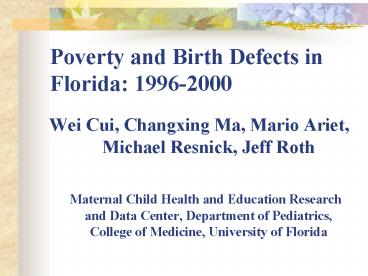Poverty and Birth Defects in Florida: 19962000 - PowerPoint PPT Presentation
1 / 21
Title:
Poverty and Birth Defects in Florida: 19962000
Description:
Birth defects are known to be the leading cause of infant death in the United ... Congenital cataract (RR: 2.6), Gastroschisis/Omphalocele (RR: 2.2). Conclusion ... – PowerPoint PPT presentation
Number of Views:32
Avg rating:3.0/5.0
Title: Poverty and Birth Defects in Florida: 19962000
1
Poverty and Birth Defects in Florida 1996-2000
- Wei Cui, Changxing Ma, Mario Ariet, Michael
Resnick, Jeff Roth - Maternal Child Health and Education Research
and Data Center, Department of Pediatrics,
College of Medicine, University of Florida
2
Background
- Birth defects are known to be the leading cause
of infant death in the United States. - Infants of poor mothers have higher rates of
mortality and morbidity than infants of non-poor
mothers. - Poverty effects on birth defects are often
confounded by factors, such as mothers
education, race and age at the time of delivery.
3
Study Question
- Are there differences in birth defects among
infants of poor and non-poor mothers, after
adjusting for differences in mothers health and
sociodemographic characteristics?
4
Methods
- The study was based on linked birth vital
statistics, Birth Defect Registry, and Medicaid
records for 972,521 livebirths between 1996 and
2000 in the State of Florida.
5
Methods
- Only birth defects detected at the time of birth
or within the first year of life were considered.
- Birth Defect Outcomes investigated
- CDCs Forty-five reported birth defects
- Eight organ system birth defects grouped by
Florida Birth Defect Registry (FBDR).
6
Methods
- Definition of Poverty mothers family income is
less than 185 of Federal Poverty Level.
7
Methods
- Six confounding variables were controlled
- 1. Mothers race (Black White and Other)
- 2. Mothers age (lt20 years 20-34 years and gt34
years) - 3. Mothers previous pregnancy experience(0
failure gt1)
8
Methods
- 4. Mothers Education ( ltHS HSgtHS)
- 5. Plurality (Singleton Multiple birth)
- 6. Infants sex (Female Male).
9
Statistical Analysis
- Generalized linear models, with the number of
children having birth defects as the response
variable were fitted using the GENMOD Procedure
in SAS. - Stepwise model selection was employed.
- The adjusted relative risks (RR) and 95
confidence intervals were estimated.
10
Results
- Among 441,205 infants born to poor mothers,
15,525 (3.5) infants had birth defects - Among 531,316 infants born to non-poor mothers,
14,897(2.8) infants had birth defects
11
Results
12
Results
13
Results
- At the organ-system level, infants of poor
mothers had a significantly higher risk of birth
defects across the eight organ systems. The three
organ systems with highest relative risks of
birth defects in poor infants were Other
defects(RR 2.2), Central Nervous System (RR
1.7), and Gastrointestinal System (RR 1.5).
14
Results
15
Results
16
Results
17
Results
- At the level of specific birth defect, a
significantly increased risk was found in 32 out
of 42 birth defects.
18
Results
- The three birth defects with highest relative
risk associated with poverty were - Birth Defects associated with maternal alcoholic
usage during pregnancy (RR 3.2), - Congenital cataract (RR 2.6),
- Gastroschisis/Omphalocele (RR 2.2).
19
Conclusion
- Infants of poor mothers have a higher risk of
birth defects than infants of non-poor mothers,
after controlling for differences in maternal
socio-demographic factors.
20
Policy Implications
- The etiology of birth defects associated with
pregnancy outcomes for poor women needs further
study. - Preconceptional education of women in poverty
potentially could reduce the risk of birth
defects and subsequently lower infant mortality
and morbidity.
21
Acknowledgments
- The authors thank Jane Correia, Florida
Department of Health, Bureau of Community
Environmental Health Jaime Frias, Josefa
Schlottman, Kimberlea W. Hauser, Birth Defect
Center, Department of Pediatrics, University of
South Florida and Li Yan, Maternal Child Health
and Education Research and Data Center,
University of Florida, a branch of the Lawton and
Rhea Chiles Center for Healthy Mothers and
Babies, for their assistance, cooperation, and
advice.































